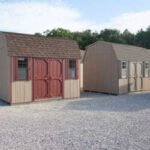Since getting the new house, we’ve had one issue – storage. What I mean by that is storing our tools and extra containers so that we have more space freed up inside the house. We definitely need a shed. But what are the best materials for building backyard storage sheds?
When considering building a backyard storage shed, you’ve got three main options. You can go with wood, metal, or plastic.
When you build a shed in your backyard, durability is critical. You want it to last as long as possible. You want to be able to afford it. You want it to be as easy as possible to get up. Also, it is best to keep its appearance as pristine as possible so that it can maintain the beauty of your yard.
How do wood, metal, and plastic meet these needs?
Is Wood Best for Building Sheds?
Wood is actually the most common material used for building storage sheds or backyard sheds meant for entertainment. Wood is an excellent choice because it’s durable and beautiful.
When you stain and paint wood, you are essentially helping to protect it from the elements and pests that might damage it. That being said, wood will last for years with proper care. Wood can rot if it’s not treated or stained and appropriately painted. It won’t rust, but you must be cautious about insects. Wood can also go up in flames if it ever catches fire.
Just remember, wood can be expensive, so if you’re on a budget, there might be a better material for you. The only problem might be that you give up the quality and craftsmanship you can get from wood if you opt for cheaper materials.
Wood is also heavy and can be hard to work with. However, this may be your best option if you can access saws and other tools that make cutting wood easier. Remember that if you want to avoid rot, you’ll need to place a wood shed on a proper foundation, which could cost more and affect where you place it.
If cost is not an issue for you, wood is usually the go-to if your goal is to have a well-built, aesthetically pleasing storage space. You can customize wood sheds in almost unlimited possibilities, while wood and plastic are limited.
Is Metal Materials Better for Building Sheds?
Metal sheds are worth considering if you plan to use your storage shed as a workshop or studio space. Metal is another excellent material for outdoor sheds because it’s sturdy and long-lasting. As a matter of fact, of all of these materials listed, it lasts the longest. You simply have to take care of it.
Metal naturally corrodes into rust, so weatherproofing is essential when choosing a metal shed. Also, rain can damage the structure over time if there are gaps between panels or holes where water can seep in. So it not only needs to be sealed well, but it needs to be painted with something that will protect the metal from rust.
You would need to handle painting and sealing with a wood shed as well. Not to mention, wood can be compromised by insects and rot, while metal cannot be damaged by either. It’s also fireproof.
Metal sheds are the least expensive of all sheds. Smaller versions can be purchased and delivered or erected on-site. Larger sheds may need to be permitted but are also reasonably easy to handle.
They are metal, so the styles are more limited than wooden sheds, especially on the inside. However, they’re also great choices if you want an industrial-looking design since metal comes in a variety of styles and finishes. And I’ve seen a lot of people successfully manage to decorate the interior and exterior of metal sheds to make them suit their surroundings just fine.
How Good are Plastic Materials for Building Sheds?
Plastic – or, more specifically, high-density polyethylene (HDPE), vinyl, or resin sheds are lightweight but still strong enough to hold up against windstorms and other natural disasters like earthquakes or tornadoes so long as they are appropriately tethered.
They’re easy to assemble—you snap together the pieces that come with your kit! The only thing you may have to prepare for is that the plastic sheds often require or are better seated on a concrete pad for good support.
However, some people prefer to avoid having plastic as part of their outdoor decor because they feel it needs to blend better with other landscape design elements. You see, plastic sheds aren’t designed for customization beyond their creation. Paint does not bind to HDPE. The good news is you can choose the color you want.
The less expensive versions do not allow the color to fade quickly. However, the cheaper sheds will have a faded look after even one year.
Over the years, the designs of HDPE sheds have become more acceptable. HDPE can be molded to look like wood, and I’ve seen sheds that look like wood that are actually plastic. With this type of shed, you never have to worry about rot, painting, or rust.
However, you will need to be sure it is adequately tethered to some type of foundation if you want it to stay put. Without a good foundation, the lighter material can be flimsy. It’s also not environmentally friendly. Sure, it might be made of recycled plastics, but what happens when you’re done with it? It can’t always be recycled again.
Sheds come in a variety of sizes, shapes, and styles. Each building material has its own pros and cons. So it’s up to you to decide which building material is suitable for your backyard shed.













